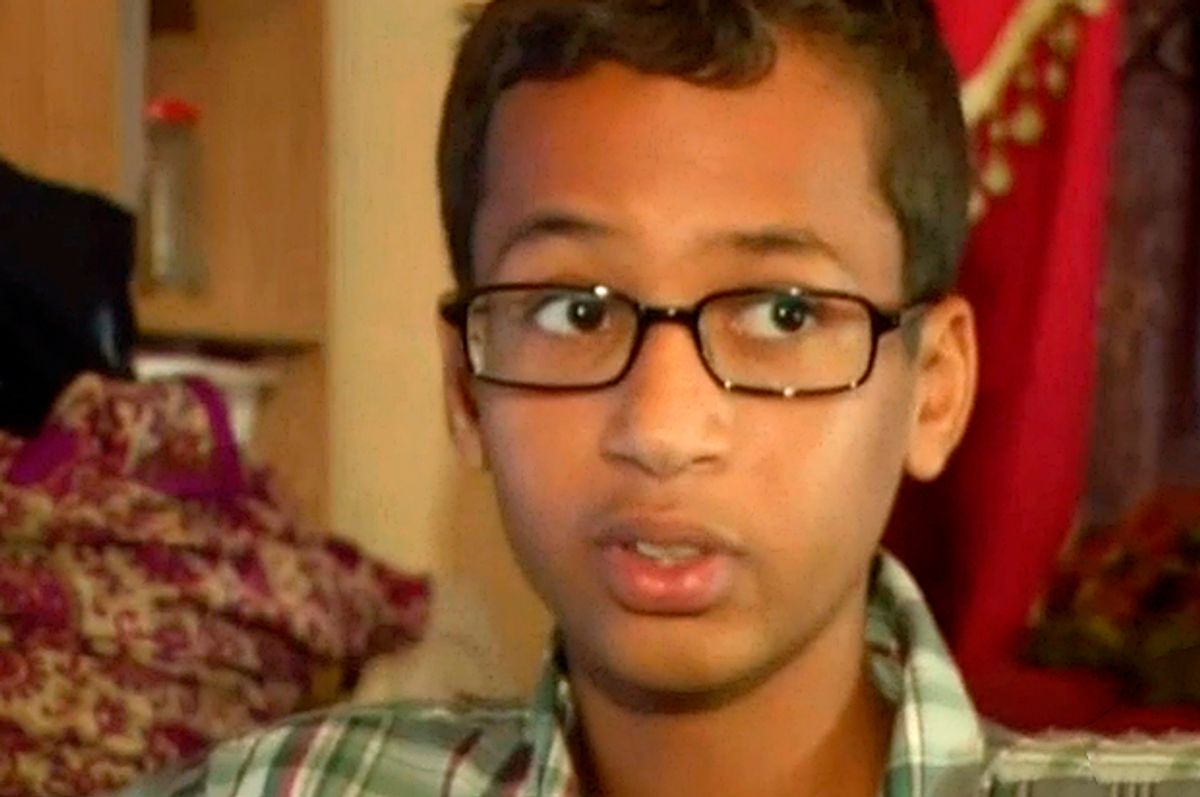Like many reasonably rational, science and technology appreciating American humans, I was appalled to awaken Wednesday to the news that 14 year-old Irving, Texas student Ahmed Mohamed had been suspended, put in handcuffs and arrested — after bringing in a homemade clock to MacArthur High. And although skeptical curiosity is apparently not welcome in certain parts, I, like a lot of people, have a lot of questions here.
Mohamed told the Dallas Morning News Wednesday that he'd loved the robotics club in middle school, and was looking for something similar this year in high school. So he quickly put together his project Sunday evening, "a circuit board and power supply wired to a digital display, all strapped inside a case with a tiger hologram on the front." But his engineering teacher told him, "That’s really nice. I would advise you not to show any other teachers." And when his English teacher saw it, she told him, "It looks like a bomb." He replied, "It doesn’t look like a bomb to me."
After he was pulled out of class, he told the principal, and then the police, that it was a clock. Police spokesman James McLellan says, "We have no information that he claimed it was a bomb. He kept maintaining it was a clock, but there was no broader explanation." (Broader explanation: It's a clock.)
At a press conference, Irving Police Chief Larry Boyd said that no charges were filed but that it was "a hoax bomb" and a "naive accident." (No, it's a clock.)
A photo of a stunned looking Mohamed, in handcuffs and his NASA t-shirt, meanwhile, quickly went viral.
Mohamed's story has become a media sensation, with many justifiably questioning whether the school's panic toward a Muslim student was racially motivated. It also attracted an outpouring of support, as the hashtag #IStandWithAhmed began trending. By Wednesday afternoon, President Obama had tweeted, "Cool clock, Ahmed. Want to bring it to the White House? We should inspire more kids like you to like science. It's what makes America great." And Kumail Nanjiani explained simply, "I don't know how to build a clock. We need kids like Ahmed around to build clocks for us."
I'm a parent of two kids close in age to Mohammed. And like any parent, I think about their safety every morning when I entrust them to their teachers every day. A few years ago, there was a troubling incident in our elementary school involving a child who'd brought in a potentially dangerous item, so I get that teachers have to make judgment calls. I also hope to God they are not so apparently biased and scared and ignorant that they make the wrong ones.
On Wednesday, I called up my friend Tom Igoe to get his perspective. Igoe teaches physical computing at NYU's ITP program, is cofounder of Arduino — a platform to teach beginners about building their own electronic devices — and has been writing and talking about making and building cool stuff for over fifteen years. His students are generally around ten years older than Mohammed, but as he says, at "about the same level of expertise as him."
I asked Igoe what draws students to classes like his, and he said, "They've been out in the world, seeing how everything going on digitally is affecting their lives, and they want to see they're how things are made so they can better decisions about using them." He says Mohammed is "not an outlier at all. In the last ten years in particular, we've seen kids his age get interested in electronics and understanding how the things they buy are built — partly because of companies that make it easier for you to assemble or customize your own things. It's what Radio Shack used to do. It's what the folks who started Make want to do."
But as as Igoe says, what happened in Texas is a case of "shifting from allowing kids to learn from experience. You're saying, We're not going to let you see how things work. We'll explain it to you in a consumerist way. What you're doing is narrowing the range of people who understand, and then narrowing the range of people who can discuss, debate and help each other. When you give kids the tools, you increase the range of what's possible. They can imagine their own future."
Otherwise, he says, "You're placing the right to imagine things only in Hollywood's hands. The teacher was like, 'That looks like a bomb.' Has that teacher ever seen a bomb? Maybe on 'NCIS.' That's not what a bomb typically looks like. If you don't understand that the thing in your pocket could just as effectively be a bomb as anything else, you're deluded and you're imagining the wrong things."
Igoe asks, "Is that same teacher going to have the kid arrested when he gets a math problem wrong? She was essentially saying, I don't know the answer to this problem, so the kid should be punished. You're replacing curiosity with fear."
Igoe hopes, however, that the attention the story has inspired can be a catalyst for change, an opportunity to truly educate. "We have to go into these things," he says. "We have to say, I understand that you have a fear. Let me help you overcome that fear."


Shares